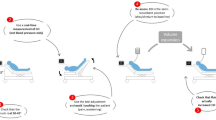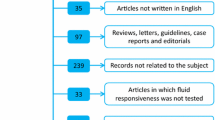Abstract
Purpose
Because severe preeclampsia (SP) may be associated with acute pulmonary oedema, fluid responsiveness needs to be accurately predicted. Passive leg raising (PLR) predicts fluid responsiveness. PLR has never been reported during pregnancy. Our first aim was to determine the percentage of SP patients with oliguria increasing their stroke volume after fluid challenge. Our second aim was to assess the accuracy of PLR to predict fluid responsiveness in those patients.
Methods
Patients with SP were prospectively included in the study. In the subgroup developing oliguria, transthoracic echocardiography was performed at baseline, during PLR and after a 500 ml fluid infusion over 15 min. Fluid responders were defined by a 15 % increase of stroke volume index. Five consecutive measurements were averaged for all parameters.
Results
Twenty-three (56 %) out of 41 patients with SP developed oliguria, 12 (52 %) out of these 23 responded to fluid challenge. During PLR, an increase of the velocity time integral of subaortic blood flow (ΔVTI) above 12 % predicted the response with a sensitivity and specificity of 75 [95 % confident interval (CI): 0.42–0.95] and 100 % (95 % CI: 0.72–1.00), respectively. An algorithm combining ΔVTI and the baseline value of VTI predicted fluid responsiveness with a sensitivity and specificity of 100 % (95 % CI: 0.74–1.00) and (95 % CI: 0.75–1.00). Urine output and respiratory variations of inferior vena cava diameter did not predict fluid responsiveness.
Conclusions
Only 52 % of oliguric patients were responders. PLR accurately predicts fluid responsiveness in the specific setting of SP. This noninvasive test should be tested in future algorithms for the management of SP.




Similar content being viewed by others
References
Duley L (2009) The global impact of pre-eclampsia and eclampsia. Semin Perinatol 33:130–137
Sibai B, Dekker G, Kupferminc M (2005) Pre-eclampsia. Lancet 365:785–799
Young P, Johanson R (2001) Haemodynamic, invasive and echocardiographic monitoring in the hypertensive parturient. Best Pract Res Clin Obstet Gynaecol 15:605–622
Barton JR, Sibai BM (2006) Life-threatening emergencies in preeclampsia-eclampsia. J Ky Med Assoc 104:410–418
Sciscione AC, Ivester T, Largoza M, Manley J, Shlossman P, Colmorgen GH (2003) Acute pulmonary edema in pregnancy. Obstet Gynecol 101:511–515
Sibai BM, Mabie BC, Harvey CJ, Gonzalez AR (1987) Pulmonary edema in severe preeclampsia-eclampsia: analysis of thirty-seven consecutive cases. Am J Obstet Gynecol 156:1174–1179
Societe francaise d’anesthesie et de reanimation. College national des gynecologues et obstetriciens francais. Societe francaise de medecine perinatale. Societe francaise de neonatalogie (2009) Multidisciplinary management of severe pre-eclampsia (PE). Experts guidelines 2008. Ann Fr Anesth Reanim 28:275–281
Lowe SA, Brown MA, Dekker GA, Gatt S, McLintock CK, McMahon LP, Mangos G, Moore MP, Muller P, Paech M, Walters B (2009) Society of obstetric medicine of Australia and New Zealand: guidelines for the management of hypertensive disorders of pregnancy 2008. Aust N Z J Obstet Gynaecol 49:242–246
Visintin C, Mugglestone MA, Almerie MQ, Nherera LM, James D, Walkinshaw S (2010) Management of hypertensive disorders during pregnancy: summary of NICE guidance. BMJ 341:c2207
Clark SL, Greenspoon JS, Aldahl D, Phelan JP (1986) Severe preeclampsia with persistent oliguria: management of hemodynamic subsets. Am J Obstet Gynecol 154:490–494
Moulin B, Hertig A, Rondeau E (2010) Kidney and preeclampsia. Ann Fr Anesth Reanim 29:e83–e90
Michard F, Teboul JL (2002) Predicting fluid responsiveness in ICU patients: a critical analysis of the evidence. Chest 121:2000–2008
Monnet X, Teboul JL (2008) Passive leg raising. Intensive Care Med 34:659–663
Monnet X, Rienzo M, Osman D, Anguel N, Richard C, Pinsky MR, Teboul JL (2006) Passive leg raising predicts fluid responsiveness in the critically ill. Crit Care Med 34:1402–1407
Maizel J, Airapetian N, Lorne E, Tribouilloy C, Massy Z, Slama M (2007) Diagnosis of central hypovolemia by using passive leg raising. Intensive Care Med 33:1133–1138
Lamia B, Ochagavia A, Monnet X, Chemla D, Richard C, Teboul JL (2007) Echocardiographic prediction of volume responsiveness in critically ill patients with spontaneously breathing activity. Intensive Care Med 33:1125–1132
Preau S, Saulnier F, Dewavrin F, Durocher A, Chagnon JL (2010) Passive leg raising is predictive of fluid responsiveness in spontaneously breathing patients with severe sepsis or acute pancreatitis. Crit Care Med 38:819–825
Ryo E, Okai T, Kozuma S, Kobayashi K, Kikuchi A, Taketani Y (1996) Influence of compression of the inferior vena cava in the late second trimester on uterine and umbilical artery blood flow. Int J Gynaecol Obstet 55:213–218
Ryo E, Unno N, Nagasaka T, Taketani Y (2004) Changes in the size of maternal inferior vena cava during pregnancy. J Perinatol Med 32:327–331
Al-Khan A, Shah M, Altabban M, Kaul S, Dyer KY, Alvarez M (2011) Measurement of intraabdominal pressure in pregnant women at term. J Reprod Med 56:53–57
Axler O, Megarbane B, Lentschener C, Fernandez H (2003) Comparison of cardiac output measured with echocardiographic volumes and aortic Doppler methods during mechanical ventilation. Intensive Care Med 29:208–217
Lang RM, Bierig M, Devereux RB, Flachskampf FA, Foster E, Pellikka PA (2006) Recommendations for chamber quantification. Eur J Echocardiogr 7:79–108
McGowan JH, Cleland JG (2003) Reliability of reporting left ventricular systolic function by echocardiography: a systematic review of 3 methods. Am Heart J 146:388–397
Feissel M, Michard F, Faller JP, Teboul JL (2004) The respiratory variation in inferior vena cava diameter as a guide to fluid therapy. Intensive Care Med 30:1834–1837
Robin X, Turck N, Hainard A, Tiberti N, Lisacek F, Sanchez JC (2011) pROC: an open-source package for R and S+ to analyze and compare ROC curves. BMC Bioinform 12:77
Gaber LW, Spargo BH, Lindheimer MD (1994) Renal pathology in pre-eclampsia. Baillieres Clin Obstet Gynaecol 8:443–468
Coudray A, Romand JA, Treggiari M, Bendjelid K (2005) Fluid responsiveness in spontaneously breathing patients: a review of indexes used in intensive care. Crit Care Med 33:2757–2762
Sarnoff SJ, Berglund E (1954) Ventricular function. Starling’s law of the heart studied by means of simultaneous right and left ventricular function curves in the dog. Circulation 9:706–718
Mahjoub Y, Touzeau J, Airapetian N, Lorne E, Hijazi M, Zogheib E, Tinturier F, Slama M, Dupont H (2010) The passive leg-raising maneuver cannot accurately predict fluid responsiveness in patients with intra-abdominal hypertension. Crit Care Med 38:1824–1829
Lakhal K, Ehrmann S, Runge I, Benzekri-Lefèvre D, Legras A, Dequin PF, Mercier E, Wolff M, Régnier B, Boulain T (2010) Central venous pressure measurements improve the accuracy of leg raising-induced change in pulse pressure to predict fluid responsiveness. Intensive Care Med 36:940–948
Jabot J, Teboul JL, Richard C, Monnet X (2009) Passive leg raising for predicting fluid responsiveness: importance of the postural change. Intensive Care Med 35:85–90
Kircher BJ, Himelman RB, Schiller NB (1990) Noninvasive estimation of right atrial pressure from the inspiratory collapse of the inferior vena cava. Am J Cardiol 66:493–496
Pierrakos C, Velissaris D, Scolletta S, Heenen S, De Backer D, Vincent JL (2012) Can changes in arterial pressure be used to detect changes in cardiac index during fluid challenge in patients with septic shock? Intensive Care Med 38:422–428
Cavallaro F, Sandroni C, Marano C, La Torre G, Mannocci A, De Waure C, Bello G, Maviglia R, Antonelli M (2010) Diagnostic accuracy of passive leg raising for prediction of fluid responsiveness in adults: systematic review and meta-analysis of clinical studies. Intensive Care Med 36:1475–1483
Shankar H, Pagel PS (2011) Potential adverse ultrasound-related biological effects: a critical review. Anesthesiology 115:1109–1124
Author information
Authors and Affiliations
Corresponding author
Additional information
For the AzuRea Group.
C. Brun and L. Zieleskiewicz contributed equally to this work.
Rights and permissions
About this article
Cite this article
Brun, C., Zieleskiewicz, L., Textoris, J. et al. Prediction of fluid responsiveness in severe preeclamptic patients with oliguria. Intensive Care Med 39, 593–600 (2013). https://doi.org/10.1007/s00134-012-2770-2
Received:
Accepted:
Published:
Issue Date:
DOI: https://doi.org/10.1007/s00134-012-2770-2




